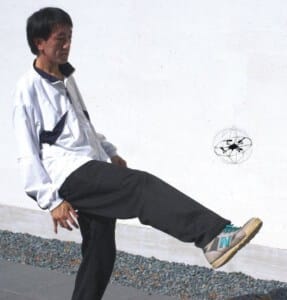An invention that disregards the laws of physics may change the dynamics of sports

In many sports ball control is a necessary skill. But what happens when the ball seemingly violates the laws of physics? The researchers at the Sony Computer Science Laboratory (Sony CSL) and the University of Tokyo are now working on just such a device: a hoverball called the HoverBall.
The HoverBall is actually a helicopter with four rotors (quadrocopter) with a diameter of 9 centimeters in a frame slightly larger than an iron ball for repulsion. It is built so that when you play it, it floats in place, moves from place to place and also changes its behavior. The device, which weighs 10 grams and is powered by a battery, can fly for five minutes. And although the newest version needs a remote control to guide the four rotors, future versions may be programmed for independent operation.
The aerial maneuvers of the HoverBall add a new layer of spontaneity to the game through "artificial laws of physics" subject to "imaginary dynamics", so said the researchers when they presented their research this year at the "Augmented Human Conference" held in Cuba, Japan.
In addition to the extraordinary flight, the Sony people want the ball to compensate for differences in player abilities, so that more people, children, the elderly and the disabled can participate in the game, says Yun Rakimoto, Sony CSL vice president.
But the HoverBall is still far from the store shelves. The flight of the helicopter depends on the intake of a lot of air, so the frame is open for now. But this shape damages the durability of the ball and limits the possibilities of using it in ball games. The researchers are considering the possibility of installing a rigid version, which might include additional, powerful rotors that would be able to fly a heavier, more closed ball with a larger battery and a more durable shell.

3 תגובות
Quidditch, anyone?
I didn't understand, is it supposed to withstand kicks and punches?
They already invented such a ball in Harry Potter...